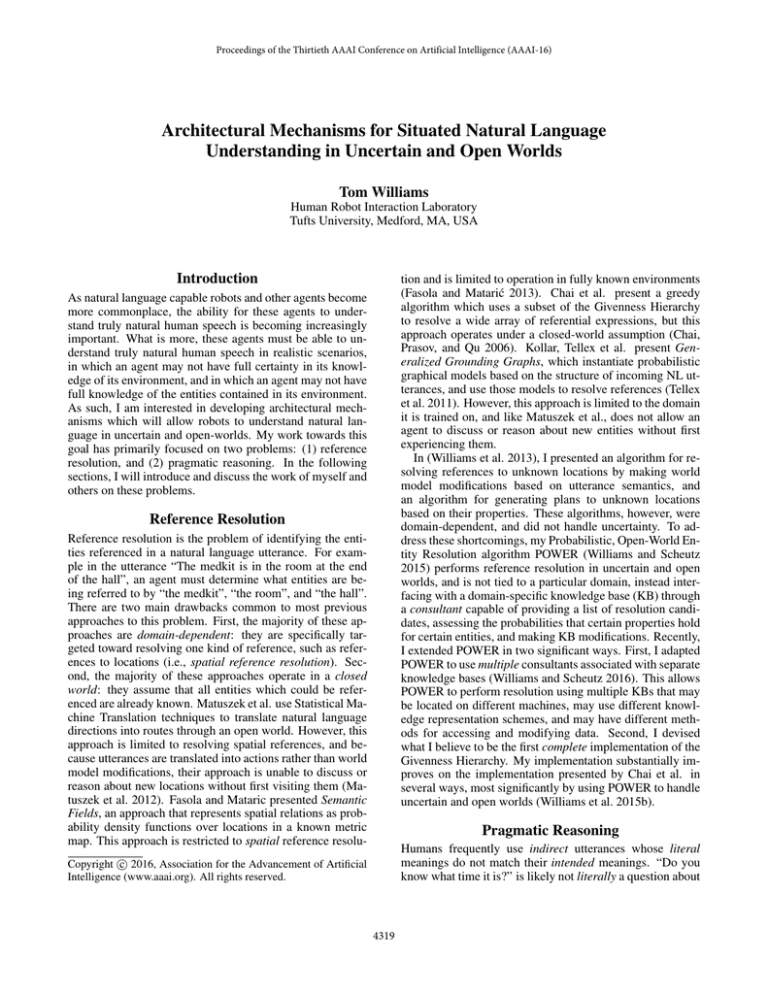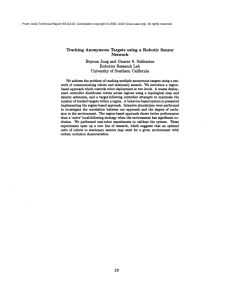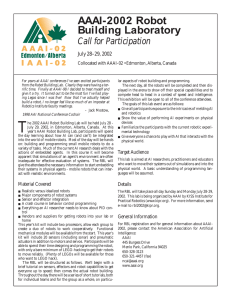
Proceedings of the Thirtieth AAAI Conference on Artificial Intelligence (AAAI-16)
Architectural Mechanisms for Situated Natural Language
Understanding in Uncertain and Open Worlds
Tom Williams
Human Robot Interaction Laboratory
Tufts University, Medford, MA, USA
Introduction
tion and is limited to operation in fully known environments
(Fasola and Matarić 2013). Chai et al. present a greedy
algorithm which uses a subset of the Givenness Hierarchy
to resolve a wide array of referential expressions, but this
approach operates under a closed-world assumption (Chai,
Prasov, and Qu 2006). Kollar, Tellex et al. present Generalized Grounding Graphs, which instantiate probabilistic
graphical models based on the structure of incoming NL utterances, and use those models to resolve references (Tellex
et al. 2011). However, this approach is limited to the domain
it is trained on, and like Matuszek et al., does not allow an
agent to discuss or reason about new entities without first
experiencing them.
In (Williams et al. 2013), I presented an algorithm for resolving references to unknown locations by making world
model modifications based on utterance semantics, and
an algorithm for generating plans to unknown locations
based on their properties. These algorithms, however, were
domain-dependent, and did not handle uncertainty. To address these shortcomings, my Probabilistic, Open-World Entity Resolution algorithm POWER (Williams and Scheutz
2015) performs reference resolution in uncertain and open
worlds, and is not tied to a particular domain, instead interfacing with a domain-specific knowledge base (KB) through
a consultant capable of providing a list of resolution candidates, assessing the probabilities that certain properties hold
for certain entities, and making KB modifications. Recently,
I extended POWER in two significant ways. First, I adapted
POWER to use multiple consultants associated with separate
knowledge bases (Williams and Scheutz 2016). This allows
POWER to perform resolution using multiple KBs that may
be located on different machines, may use different knowledge representation schemes, and may have different methods for accessing and modifying data. Second, I devised
what I believe to be the first complete implementation of the
Givenness Hierarchy. My implementation substantially improves on the implementation presented by Chai et al. in
several ways, most significantly by using POWER to handle
uncertain and open worlds (Williams et al. 2015b).
As natural language capable robots and other agents become
more commonplace, the ability for these agents to understand truly natural human speech is becoming increasingly
important. What is more, these agents must be able to understand truly natural human speech in realistic scenarios,
in which an agent may not have full certainty in its knowledge of its environment, and in which an agent may not have
full knowledge of the entities contained in its environment.
As such, I am interested in developing architectural mechanisms which will allow robots to understand natural language in uncertain and open-worlds. My work towards this
goal has primarily focused on two problems: (1) reference
resolution, and (2) pragmatic reasoning. In the following
sections, I will introduce and discuss the work of myself and
others on these problems.
Reference Resolution
Reference resolution is the problem of identifying the entities referenced in a natural language utterance. For example in the utterance “The medkit is in the room at the end
of the hall”, an agent must determine what entities are being referred to by “the medkit”, “the room”, and “the hall”.
There are two main drawbacks common to most previous
approaches to this problem. First, the majority of these approaches are domain-dependent: they are specifically targeted toward resolving one kind of reference, such as references to locations (i.e., spatial reference resolution). Second, the majority of these approaches operate in a closed
world: they assume that all entities which could be referenced are already known. Matuszek et al. use Statistical Machine Translation techniques to translate natural language
directions into routes through an open world. However, this
approach is limited to resolving spatial references, and because utterances are translated into actions rather than world
model modifications, their approach is unable to discuss or
reason about new locations without first visiting them (Matuszek et al. 2012). Fasola and Mataric presented Semantic
Fields, an approach that represents spatial relations as probability density functions over locations in a known metric
map. This approach is restricted to spatial reference resolu-
Pragmatic Reasoning
Humans frequently use indirect utterances whose literal
meanings do not match their intended meanings. “Do you
know what time it is?” is likely not literally a question about
c 2016, Association for the Advancement of Artificial
Copyright Intelligence (www.aaai.org). All rights reserved.
4319
Acknowledgments
whether or not you know the time, but more likely an indirect request for the time, using indirectness as a politeness
strategy; “The commander is wounded and needs a medical
kit!” is likely not a simple statement of fact, but is more
likely an indirect command to bring the wounded commander a medical kit, or perhaps a request to know where to find
a medical kit. The few language-capable robot architectures
able to handle these types of non-literal utterances (known as
indirect speech acts (ISAs)) (e.g., (Wilske and Kruijff 2006),
and our own architecture, (Briggs and Scheutz 2013)) are
not robust to uncertain contexts.
To address this problem, my algorithms for understanding and generating ISAs (Williams et al. 2015a), use a
Dempster-Shafer (DS) theoretic representation to encode
the uncertainty of (1) incoming utterances, (2) the robot’s
knowledge, and (3) the pragmatic rules used by the robot to
map an utterance and context to an intention and to to abduce
the best utterance to use to communicate an intention. Using a DS-theoretic representation allows the robot to assess
its own ignorance, and thus to acknowledge when it does
not have enough information to understand an utterance.
My work has been supported in part by ONR grants
#N00014-11-1-0289, #N00014-11-1-0493, #N00014-10-10140 #N00014-14-1-0144, #N00014-14-1-0149, #N0001414-1-0751}, and NSF grants #1111323, #1038257.
References
Briggs, G., and Scheutz, M. 2013. A hybrid architectural
approach to understanding and appropriately generating indirect speech acts. In Proceedings of the 27th AAAI Conf.
on Artificial Intelligence.
Chai, J. Y.; Prasov, Z.; and Qu, S. 2006. Cognitive principles
in Robust multimodal interpretation. Journal of Artificial
Intelligence Research.
Fasola, J., and Matarić, M. J. 2013. Using semantic fields
to model dynamic spatial relations in a robot architecture for
natural language instruction of service robots. In IEEE/RSJ
Int’l Conference on Intelligent Robots and Systems.
Matuszek, C.; Herbst, E.; Zettlemoyer, L.; and Fox, D. 2012.
Learning to parse natural language commands to a robot
control system. In Proceedings of the 13th International
Symposium on Experimental Robotics.
Tellex, S.; Kollar, T.; Dickerson, S.; Walter, M.; Banerjee,
A.; Teller, S.; and Roy, N. 2011. Approaching the symbol
grounding problem with probabilistic graphical models. AI
magazine.
Williams, T., and Scheutz, M. 2015. POWER: A domainindependent algorithm for probabilistic, open-world entity
resolution. In IEEE/RSJ International Conference on Intelligent Robots and Systems.
Williams, T., and Scheutz, M. 2016. A framework for
resolving open-world referential expressions in distributed
heterogeneous knowledge bases. In Proc. of the Thirtieth
AAAI Conference on Artificial Intelligence.
Williams, T.; Cantrell, R.; Briggs, G.; Schermerhorn, P.; and
Scheutz, M. 2013. Grounding natural language references
to unvisited and hypothetical locations. In Proceedings of
the 27th AAAI Conference on Artificial Intelligence.
Williams, T.; Briggs, G.; Oosterveld, B.; and Scheutz, M.
2015a. Going beyond command-based instructions: Extending robotic natural language interaction capabilities. In
Proceedings of Twenty-Ninth AAAI Conference on Artificial
Intelligence.
Williams, T.; Schreitter, S.; Acharya, S.; and Scheutz, M.
2015b. Towards situated open world reference resolution.
In AAAI Fall Symposium on AI for HRI.
Wilske, S., and Kruijff, G.-J. 2006. Service robots dealing
with indirect speech acts. In IEEE/RSJ International Conference on Intelligent Robots and Systems.
Research Plan and Contribution
As an extension to my previous work on open-world reference resolution, I am designing mechanisms to allow a
robot to perform inference using information contained in
distributed, heterogeneous KBs. As an extension to my previous work on pragmatic reasoning, I am designing one-shot
learning algorithms for learning new pragmatic rules. I expect to perform research on the following problems between
AAAI 2016 and my expected graduation date of May 2017:
As an extension of my work on open-world reference resolution, I will: (1) examine the effect of different variableordering strategies in the POWER algorithm, (2) examine
the effects of different probability thresholds in the POWER
algorithm, (3) convert the POWER algorithm to use a DStheoretic knowledge representation scheme, in order to allow the robot to reason about its own ignorance when performing reference resolution, (4) integrate a consultant with
semantic mapping capabilities into our architecture, (5) examine different ways of calculating cross-modality salience
scores for use in my Givenness Hierarchy implementation,
and (6) integrate common-sense and affordance-based reasoning capabilities into my Givenness Hierarchy implementation. As an extension of my work on pragmatic reasoning,
I will develop mechanisms for altering the context and confidence of previously learned pragmatic rules. Finally, I will
perform a comprehensive, extrinsic evaluation of my suite
of architectural mechanisms on a physical robot, and examine human perceptions of the capabilities afforded by these
mechanisms.
The contribution of this dissertation will thus be a set of
architectural mechanisms for natural language understanding and generation in uncertain and open worlds, extending
the state of the art on a variety of problems important for
natural human-robot dialogue.
4320




